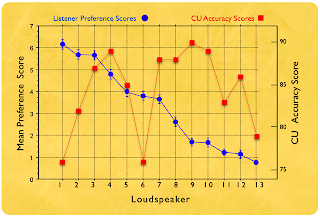Obviously Noel Keywood doesn't know one end of a scope from the other! But then he doesn't have a serious 'Weed Up His Ass' where ML are concerned.
"MEASURED PERFORMANCE
The vertical high frequency panel of the CLX is a little directional, but less so than the budget Martin Logan models; moving the measuring microphone laterally in front of the CLX altered the basic high to low energy balance, rather than upsetting frequency response. This means midrange and treble remains as smooth and extended as our stepped sine wave analysis shows, moving up or down in prominence, as listening position changes, relative to bass and midrange frequencies below 1kHz. So whilst the CLX is listening position critical, it isn’t too demanding in this respect. It also drove our 28ft square measuring room well, much like the Kingsound Prince II tested in our April 09 issue, giving a consistent sound over a wide frontal area.
Frequency response of the CLX is flat from 700Hz all the way up to 20kHz, so it will sound even in its midband and upper midband/treble delivery. Below 700Hz output is on average 3dB up, right down to 55Hz no less. With a monopole this would give a fulsome balance, but with a dipole it gives a natural balance, likely because the solid radiation angle and associated acoustic power is less. A low frequency peak at 60Hz (third octave analysis, not shown here) suggests there will be no lack of punchy bass. This looks like a carefully tailored euphonic balance that will be easy on the ear.
Electrostatics are usually insensitive but the CLX isn't much different from conventional loudspeakers in this area, producing 84dB sound pressure level from one nominal Watt of input (2.84V). This is far better than the 11dB less sensitive (73dB) Kingsound Prince IIs for example. The CLX is a similar amplifier load however, comprising a huge low frequency peak, our analysis shows, reaching a maximum of 125 Ohms at 16Hz, falling to 11 Ohms DCR at 0Hz and 1.5 Ohms at 20kHz. Above 100Hz impedance falls below 15 Ohms and the overall figure measured a normal 5.5 Ohms. The CLX is reactive at low frequencies only, which should not be a problem to amplifiers. Above 300Hz it is largely resistive, making it an easy amplifier load, except for the 1.5 Ohm minimum at 20kHz which could conceivably be too demanding for some solid-state amplifiers. Again, valve amplifiers cope best.
The loudspeaker’s spectral decay over 200mS showed there is remarkably little colouration, a strength of the electrostatic, and decay is fast and even across the frequency spectrum, with a small amount of overhang at 60Hz as expected. Distortion levels were a little above conventional loudspeakers and varied across the bass panel area below 100Hz, falling from 3% at 40Hz down to 1% or so at 100Hz, then around 0.3% up to 1kHz, falling to 0.1% to 6kHz.
The CLX delivers a smooth yet extended sound into the room, free from serious frequency response anomalies. The balance emphasises lows a little, for warmth and body, and low bass output is strong and deep. Its basic accuracy and smoothness of output is excellent for such a big panel, it drives the room evenly and colouration is extremely low, so this is a quality design. NK "

















